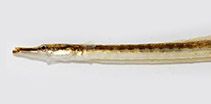| Family: |
Syngnathidae (Pipefishes and seahorses), subfamily: Nerophinae |
| Max. size: |
21 cm TL (male/unsexed) |
| Environment: |
demersal; freshwater; brackish; marine |
| Distribution: |
Africa: east coast from Sabaki River, Kenya, to Coffee Bay, South Africa (Ref. 4127, 52193); also Madagascar (Ref. 4127, 52193). Reported from Zimbabwe (Ref. 13337). |
| Diagnosis: |
Dorsal spines (total): 0-0; Dorsal soft rays (total): 60-69; Anal spines: 0-0; Anal soft rays: 4-4. Description: Dorsal fin with 60-69 rays; anal fin with 4 rays (Ref. 52193). Rings (18-20)+(21-23); anal ring about midway along length of fish (Ref. 52193). Male brood-pouch abdominal, without protective membranous folds (Ref. 52193). Colouration: Bluish green to yellowish brown with fine black streaks (Ref. 52193). |
| Biology: |
It occurs in coastal rivers and streams (Ref. 4127) where it can be found in quiet water amongst vegetation (Ref. 30558, 52193) or in the vicinity of logs at river edges (Ref. 30558). It is ovoviviparous (Ref. 205). During mating the female passes eggs to the male and the eggs become fertilized as they pass into the pouch of the male (Ref. 30558). The male brood the eggs and larvae in an abdominal pouch (Ref. 7248, Ref. 30558). After about three weeks the pouch opens and the male gives birth to fully formed young (Ref. 30558). The young begin to feed soon and may take refuge in the male pouch if necessary (Ref. 30558). It probably feeds on minute invertebrate organisms such as crustaceans and insects (Ref. 30558, 52193). |
| IUCN Red List Status: |
Data deficient (DD); Date assessed: 26 November 2015 Ref. (130435)
|
| Threat to humans: |
harmless |
Source and more info: www.fishbase.org. For personal, classroom, and other internal use only. Not for publication.

